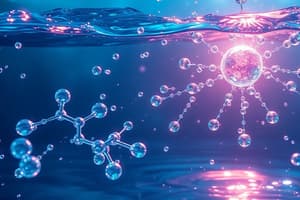Podcast
Questions and Answers
What is the net equation for the reaction of carbon dioxide and water?
What is the net equation for the reaction of carbon dioxide and water?
- CO2(g) + H+(aq) ⇌ HCO3−(aq)
- CO2(g) + O2(l) ⇌ H2CO3(aq)
- CO2(g) + H2O(l) ⇌ H+(aq) + HCO3−(aq) (correct)
- CO2(aq) + H2(g) ⇌ H2CO3(aq)
What is a common example of an in vitro buffer system?
What is a common example of an in vitro buffer system?
- Phosphate buffer system
- Zwitterion buffer system
- Bicarbonate buffer system
- Tris buffer system (correct)
Which of the following describes zwitterions?
Which of the following describes zwitterions?
- Compounds with only a positive charge
- Compounds with only a negative charge
- Compounds that can act as both acids and bases
- Compounds that have both a positive and negative charge (correct)
Which buffer system is known to be prevalent in the living body?
Which buffer system is known to be prevalent in the living body?
What is the main role of buffers in biochemical reactions?
What is the main role of buffers in biochemical reactions?
Which statement about buffers is false?
Which statement about buffers is false?
What is the pH of a 1×10–3 M HCl solution?
What is the pH of a 1×10–3 M HCl solution?
What is the pH of a 1×10–4 M NaOH solution?
What is the pH of a 1×10–4 M NaOH solution?
Which hydronium ion concentration corresponds to a pH of 10.0?
Which hydronium ion concentration corresponds to a pH of 10.0?
Why does pepsin have maximum activity under very acidic conditions?
Why does pepsin have maximum activity under very acidic conditions?
Which enzyme has maximum activity near pH 5?
Which enzyme has maximum activity near pH 5?
What concentration of hydroxide ions is found in a solution with a pH of 3?
What concentration of hydroxide ions is found in a solution with a pH of 3?
What determines the effective range of a buffer solution?
What determines the effective range of a buffer solution?
Which of the following options describes buffering capacity?
Which of the following options describes buffering capacity?
How can a buffer solution be prepared in the laboratory starting from the weak acid?
How can a buffer solution be prepared in the laboratory starting from the weak acid?
What is the principal buffer pair found in cells?
What is the principal buffer pair found in cells?
What is the pKa value of carbonic acid in the blood buffering system?
What is the pKa value of carbonic acid in the blood buffering system?
What happens to the pH of a buffer when OH– is added?
What happens to the pH of a buffer when OH– is added?
Which enzyme catalyzes the conversion of CO2 to bicarbonate in the blood?
Which enzyme catalyzes the conversion of CO2 to bicarbonate in the blood?
What is the general effect of increasing the concentrations of a weak acid and its conjugate base on buffering capacity?
What is the general effect of increasing the concentrations of a weak acid and its conjugate base on buffering capacity?
What is the pKa value used in the example for calculating the new pH?
What is the pKa value used in the example for calculating the new pH?
What does the Henderson–Hasselbalch equation help calculate in a buffer system?
What does the Henderson–Hasselbalch equation help calculate in a buffer system?
What determines the polarity of a bond in a water molecule?
What determines the polarity of a bond in a water molecule?
Which atom in a water molecule has a negative charge due to electron sharing?
Which atom in a water molecule has a negative charge due to electron sharing?
According to Le Chatelier’s principle, what happens when H+ ions are added to a buffer system?
According to Le Chatelier’s principle, what happens when H+ ions are added to a buffer system?
At the inflection point of a titration curve, what proportion of the original acid has been converted to the conjugate base?
At the inflection point of a titration curve, what proportion of the original acid has been converted to the conjugate base?
How does the geometry of a molecule affect its polarity?
How does the geometry of a molecule affect its polarity?
Which of the following molecules is considered nonpolar despite having polar bonds?
Which of the following molecules is considered nonpolar despite having polar bonds?
When the pH is one unit higher than pKa, what is the ratio of conjugate base to conjugate acid?
When the pH is one unit higher than pKa, what is the ratio of conjugate base to conjugate acid?
Which ion concentrations are used in the Henderson–Hasselbalch equation in this example?
Which ion concentrations are used in the Henderson–Hasselbalch equation in this example?
Which type of bond is held together by positive and negative ions?
Which type of bond is held together by positive and negative ions?
What is the effect of stress on a buffer system according to Le Chatelier’s principle?
What is the effect of stress on a buffer system according to Le Chatelier’s principle?
What is the primary role of water as a solvent in living systems?
What is the primary role of water as a solvent in living systems?
Which stage of phosphoric acid ionization is the focus of the buffer mentioned in this example?
Which stage of phosphoric acid ionization is the focus of the buffer mentioned in this example?
What describes a nonpolar bond?
What describes a nonpolar bond?
What is the result of differences in electronegativity between atoms in a bond?
What is the result of differences in electronegativity between atoms in a bond?
Flashcards are hidden until you start studying
Study Notes
Water and Polarity
- Water is a vital component of most cells and its molecular geometry significantly influences biological properties.
- Electronegativity refers to an atom's ability to attract electrons; oxygen and nitrogen are more electronegative than carbon and hydrogen.
- Polar bonds arise when electrons are shared unequally, resulting in a molecule having a positive end and a negative end.
- A molecule can contain polar bonds but remain nonpolar overall, as seen in CO2 due to its linear geometry.
Solvent Properties of Water
- Ionic bonds form when positive and negative ions attract each other, facilitating various biochemical reactions.
- In pure water, the concentration of hydrogen ions ([H+]) is 1×10–7 M, leading to a neutral pH of 7.0.
- Example calculations show that 1×10–3 M HCl gives a pH of 3, while 1×10–4 M NaOH gives a pH of 10.0.
- pH levels are crucial for enzyme activity; enzymes like pepsin and trypsin show optimal activity within specific pH ranges.
Buffers and Their Mechanisms
- Buffers maintain a stable pH by resisting changes when acids or bases are added, following Le Chatelier's principle.
- Buffer systems are crucial in maintaining homeostasis, with the equilibrium defined by reactions involving weak acids (HA) and their conjugate bases (A−).
- The Henderson-Hasselbalch equation can be used to calculate pH based on the ratio of acid and base concentrations.
Titration and Buffer Action
- Titration curves provide insights into buffer effectiveness, showing pH stability in the presence of added acids or bases.
- At an inflection point on a titration curve, equal concentrations of acid and conjugate base exist, allowing effective buffering capacity.
Biological Buffers
- The H2PO4–/HPO42– buffer system is prominent in biological systems, providing stability in cellular environments.
- Carbonic acid (H2CO3) dissociates in blood to maintain pH around 7.4, with carbonic anhydrase catalyzing CO2 to bicarbonate ion (HCO3−) conversion.
- Phosphate buffer systems, such as TRIS, are commonly utilized in laboratory settings, both in vitro and in vivo.
Key Buffer Properties
- Buffers are effective within two pH units of the pKa of the acid component, with greater concentrations of weak acid and conjugate base increasing buffering capacity.
- Biological buffers include zwitterions, which possess both positive and negative charges, and are less likely to interfere with biochemical processes compared to older buffer systems.
Studying That Suits You
Use AI to generate personalized quizzes and flashcards to suit your learning preferences.





